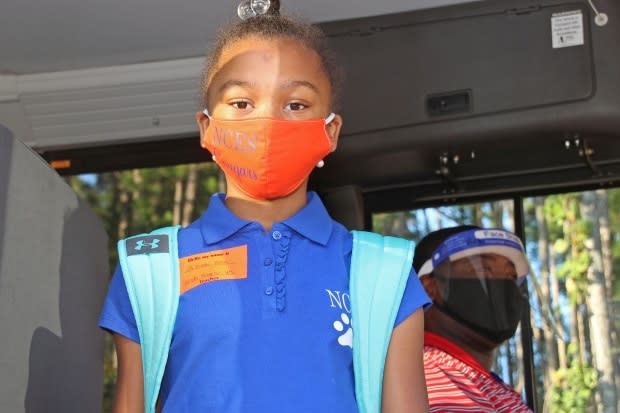Can kids still see their grandparents? Your back-to-school COVID-19 questions answered

We're breaking down what you need to know about the pandemic. Send us your questions via email at COVID@cbc.ca, and we'll answer as many as we can. We'll publish a selection of answers on our website, and we're also putting some of your questions to the experts on the air during The National and on CBC News Network. So far, we've received more than 51,000 emails from all corners of the country.
Can kids still see their grandparents?
With the first day of school just weeks away, one of the most frequently asked questions we're getting is from worried grandparents.
Lynda B. wrote to say she's particularly concerned because she's close to four of her grandchildren, and her son is also a teacher.
The answer, most experts say, is "Yes." But parents may need to rethink the type of precautions they take for now.
Dr. Dina Kulik, a pediatrician and founder and director of Kidcrew Pediatrics, said that people over 60 are particularly at risk of getting very sick or dying of COVID-19 and urged a cautious approach until the impact of school reopening on transmission of the disease caused by the coronavirus is clear.
"Until we see that, the most conservative thing would be to maintain your distance from people that are at risk," she told CBC News Network.
Dr. Susy Hota, medical director of the infection prevention and control department at the University Health Network and an assistant professor of medicine at the University of Toronto, agreed but said that doesn't mean cutting off contact with grandparents.
"It will be still possible to have these kinds of visits but important to maintain physical distancing, as well as hopefully be outdoors or in settings that are lower risk," she told CBC's The National.
WATCH | Back to school: What teachers and students can do to prevent coronavirus spread:
Kulik acknowledged that sometimes families rely on grandparents for pickups and child care. In those cases, she recommended that when caring for the children, grandparents wear a mask, maintain distance as much as possible, wash everyone's hands with soap or sanitizer and avoid bringing them inside the home if possible.
If children live with their grandparents, she recommends separating them as much as possible.
That said, in areas without known community transmission, such as the Northwest Territories, experts say the risk is low if you maintain your bubble and limit contacts outside school.
"I would say continue with your bubble with your grandchildren. We'll monitor the situation as the fall begins," N.W.T. Chief Public Health Officer Dr. Kami Kandola recently told CBC News. "The only scenario when we would ask you to limit your bubble, [is] if there was a case of COVID[-19] in the class of your grandchild."
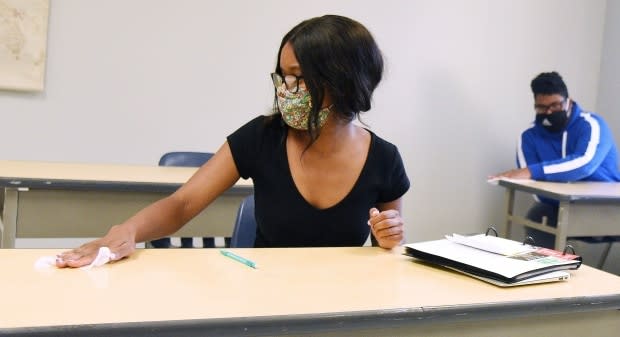
What happens if my kid gets symptoms?
Parents and teachers know that back-to-school typically means back to sniffles and sick days, but readers like Aquino L. want to know more about the protocols should kids get sick — or worse, test positive.
Federal guidelines recommend that students, staff or volunteers not be allowed in the school or to board the school bus if:
They have symptoms of COVID-19.
They have had exposure to someone with COVID-19 in the last 14 days.
That means if a child tests positive, siblings need to self-isolate. And if another household member tests positive, a child needs to be removed from school, even if he or she is asymptomatic. This has already happened in at least some school districts that have returned to school.
The federal guidelines are only recommendations, and actual rules can vary from province to province, from school board to school board.
However, Kulik says ideally the whole family should self-isolate if one child in the family is exposed, given the evidence of asymptomatic spread of the coronavirus. "The most conservative way would be to isolate anyone exposed and the people exposed to those people."
Students should also stay home from school if someone outside their family but within their social bubble has symptoms, recommends epidemiologist Dara Spatz Friedman.
Students may also have to self-isolate if someone in their class tests positive, as happened at a summer school in Calgary in July — but not necessarily.
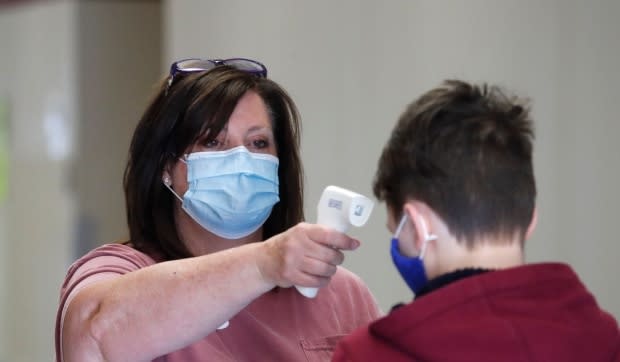
Why can't we just test everyone before going back to school?
In addition to getting some new clothes and maybe their first face masks, Lynda B. is wondering if parents should have their kids tested before returning to school.
While that sounds like a good idea, it's actually complicated in practice.
Some places, such as Alberta, are recommending that teachers and school staff get tested before going back to school and regularly throughout the year. However, even that province says that testing teachers and staff alone will strain the province's testing capacity. It is only recommending students be tested if they have symptoms or pre-existing medical conditions that have symptoms similar to COVID-19, such as allergies.
"Having a test done before school to ensure these unchanged symptoms are not a sign of COVID-19 helps as a baseline for parents to monitor from as their children go back to school," said Dr. Deena Hinshaw, the province's chief medical officer.
Kulik doesn't recommend testing kids before school starts, noting that false negatives are common for COVID-19 tests, especially in people without symptoms.
"I don't want to give people a false sense of security or false hope that they don't have it," she said.
She said in her work as a pediatrician, she has also taken care of many kids with COVID-19 symptoms whose families tested positive, but who tested negative themselves, and wonders if the test might be less reliable in children.
WATCH | Back to school: How will social bubbles work?
Where is a student more likely to be exposed?
We know that taking activities outdoors and avoiding dense crowds can help reduce the spread of coronavirus.
But Carl B. is wondering which school situation would be riskier: a hallway crammed with hundreds of mask-wearing students or a few dozen kids not wearing masks in class?
The answer is: it depends.
"Closed spaces, lots of people, poor ventilation, no masks are all situations where transmission would be [likely]," said infectious diseases specialist Dr. Srinivas Murthy, referring to large scale spreading events earlier in the pandemic.
Open spaces with masks "would, I guess, be a lower risk," said Murthy. However, physical distancing and improved ventilation can help limit the risks, he said, even in smaller enclosed spaces.
The duration of exposure, the number and concentration of people are all factors that need to be considered when calculating risk, said Hota.
"Transient passage in a hallway, especially wearing masks, seems to be a fairly low-risk situation compared to sitting in a classroom for hours."
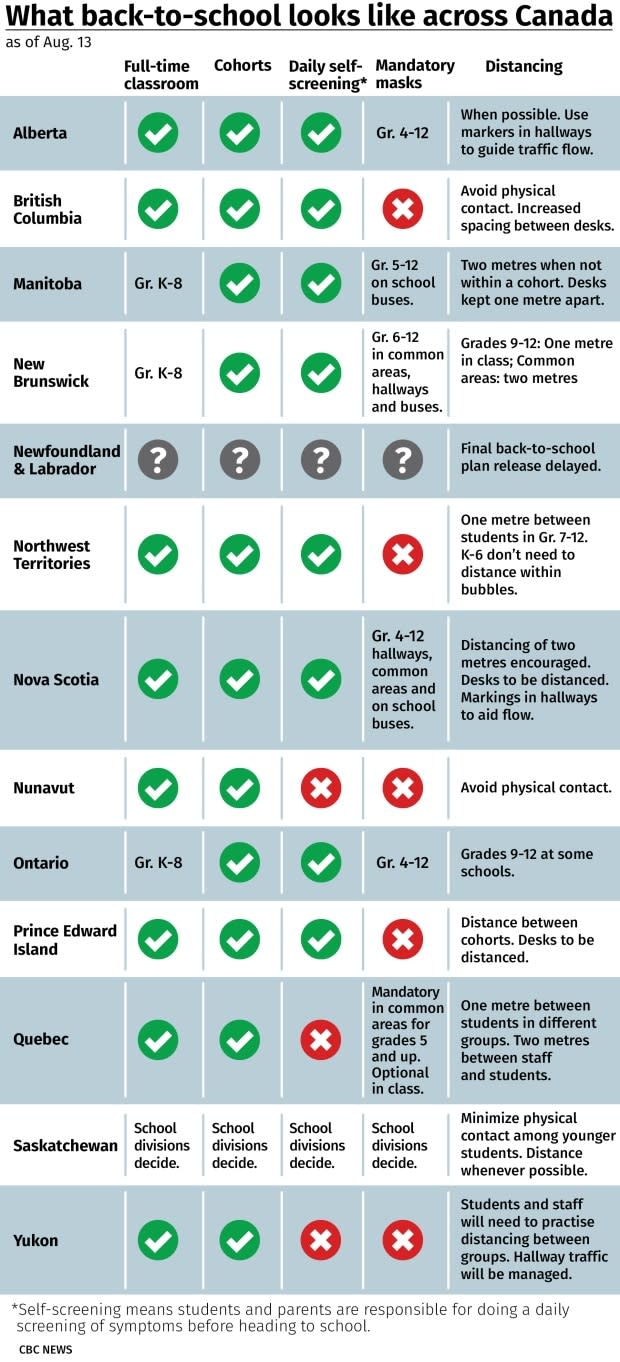
So, then why don't all children have to wear a mask in class? What about face shields?
Federal guidelines do recommend that students over age 10 wear non-medical cloth masks. However, it's up to provinces to set rules about whether and when that happens in schools based on a "setting-specific risk assessment" of factors, such as the level of local transmission and the ability to implement other risk mitigation measures.
Some provinces are requiring children above a certain grade to wear masks at all times, some require them only in common areas, such as hallways, and some don't require them at all. Ontario "encourages" masks even when they're not required, and Alberta recommends staff ask younger students who are able to tolerate masks to wear them when possible.
Face shields are recommended by the federal government as eye protection for teachers and staff, to be used alongside a face mask. They are not generally recommended as a face covering because of a lack of evidence of their effectiveness at blocking respiratory droplets, according to the U.S. Centers for Disease Control and Prevention (there is some evidence that face shields without masks don't offer protection).

Is it too risky to take the school bus?
We've received a number of messages from parents who are concerned about putting their kids on the bus, including Natasha K. who asked if she could do it "in good conscience."
"It's a family decision," said Kulik, who has four children, and, like many Canadians, doesn't have the opportunity to work from home.
"This is a really hard time for a lot of families, and there is no right answer."
That said, there are things you can do to make travelling to school during a pandemic safer.
"If you can, I would wear a mask," said Kulik, who also said opening the windows and maintaining physical distancing would be key.
Most back-to-school bus plans across the country include measures such as extra cleaning and disinfecting, personal protective equipment for students and drivers and assigned seating.
British Columbia says each student should have their own seat "unless sharing with a member of their household." While Quebec recommends a maximum of two students per bench.
Ontario's plan indicates that buses will likely operate "closer to capacity"— which means larger buses would carry upwards of 70 students.
"That is going to put the bus drivers at risk, who are usually older adults," said Kulik. And some drivers have already said they'd rather retire than take the risk.
Manitoba and New Brunswick are two provinces counting on more parents driving their kids to school.
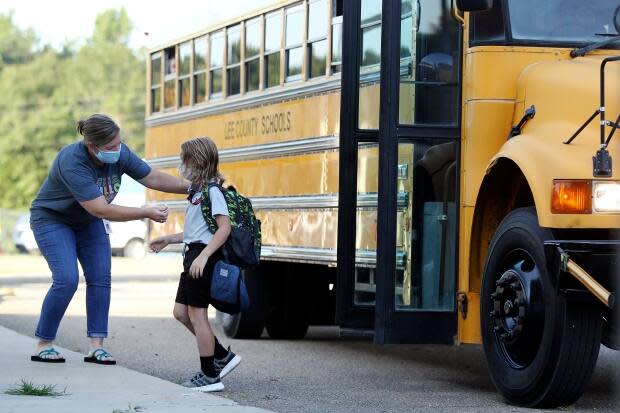
Should kids and teachers change their clothes when they get home?
Doctors and nurses strip off their scrubs before coming home from the hospital, but readers like Stephanie L. and Doug P. wonder whether kids and teachers should do the same thing after school.
Our experts didn't agree on whether students and educators should observe the same level of fastidiousness.
"Your best bet — if you want to be very conservative — would be to change [your clothes] on your arrival home," said Kulik. "And maybe shower, but for sure, wash your hands very diligently."
Health workers are careful to change their clothes because they work closely with patients who are confirmed or suspected to have COVID-19, said Murthy, an investigator at BC Children's Hospital in an interview on The National.
"This is a very different situation from teachers or others where the risk of exposure is much, much lower," said Murthy. "So at this point, we wouldn't recommend that teachers or others who work in schools to take that level of precaution."
Hota agreed.
"We're learning, over time, that the virus doesn't really last on surfaces for that long, particularly on clothing," she said.
Hota said cleaning your hands and not touching your face would be a more effective way of mitigating the risk.
